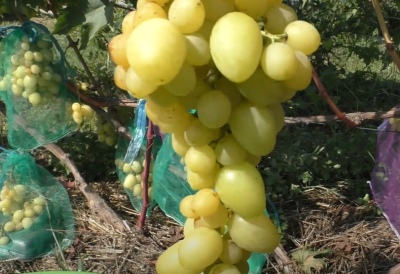
- Authors: Kapelyushny Vasily Ulyanovich
- Appointment: dining room
- Berry color: amber yellow
- Taste: harmonious, light nutmeg aroma
- Ripening period: very early
- Ripening period, days: 95-105
- Frost resistance, ° C: -24
- Bunch weight, g: 700-1200
- Flower type: bisexual
- Density of the bunch: medium
Zlato is a good grape variety with beautiful bunches and tasty berries, which is why it is widespread and in great demand.
Breeding history
Table grapes Zlato appeared thanks to Vasily Ulyanovich Kapelyushny, who bred it with the help of the Talisman and Novocherkassky raisins varieties.
Description
To understand whether this variety is needed on the site, you should study its characteristics, as well as the positive and negative qualities.
Ripening period
Large clusters ripen for about 95-105 days, the ripening period is very early.
Bunches
A bunch of conical shape and medium density, weighs about 700-1200 g. It has excellent transportability. The fruits can be transported both short and long distances.
Berries
Large fruits ripen amber-yellow with edible skin and fleshy juicy pulp. They are oval in shape. One grape weighs about 10-12 g.
Taste
The berries have a harmonious taste and not too strong, unobtrusive nutmeg aroma.
Yield
The variety is high-yielding, gives a regular, plentiful and high-quality harvest.


Growing features
Gold is not a very whimsical variety, but in order to grow a healthy and fertile crop, you need to know some of the nuances of its cultivation.
Landing
The grape is a southern plant that enjoys warm climates, but this variety can be grown in areas with a fairly cold climate. When planting, it is important to choose the right place and prepare it well.
The ideal option for planting a seedling is the wall of the building, but it can also be a fence on the south side of the territory. You should retreat from the wall about half a meter, and (subject to planting the culture with a single vine) dig a hole, the depth of which is 60 cm.If you need to plant 2-3 vines, you need to dig a trench 60 cm deep and wide.Root dressing is placed at a depth of about 40 cm ...
Nearby (along the length of the planting pit or trench), a wire is stretched in 2-3 rows. The first row is located above the soil at a height of 30 cm.The distance between 1 and 2 rows should be 40 cm, between 2 and 3 - 50 cm.

Pollination
The flowers are bisexual, so the variety is capable of self-pollination.
Pruning
Before covering the plant, it must be cut off. In the first year, only one shoot with 3-4 eyes is left on the seedling. In the second year, 2 shoots are left with 3-4 eyes on each of them.
The optimal load on the bush is 40-45 eyes, pruning vines for 6-8 eyes.



Frost resistance and the need for shelter
The variety is able to withstand frosts down to -24 degrees. For the winter, the vine is sheltered in several ways.
Sprinkled with sawdust, branches and leaves, boards are placed on top;
Arcs are installed above the vine at a height of about 30 cm, material is stretched on them (in 3 layers), which retains heat.

Diseases and pests
Gold is resistant to mildew, oidium and gray rot by 2 points. To avoid infection with diseases or attacks of pests, it is necessary to carry out preventive measures using both special means and folk methods. This will help keep the grapes healthy and not lose a good harvest.

If a grape is exposed to any disease or insect, this always affects its appearance.
Storage
The bunches can be stored for quite a long time in proper conditions.
Review overview
There is a pleasant harmonious taste of grapes. Some believe that it can be consumed not only fresh. You can eat grapes very early.
It is not difficult to care for a crop if it is grown in comfortable climatic conditions. Timely feeding, pruning and watering is enough for the variety to give a good and tasty harvest. It is very popular with many gardeners and is widely used by them.











































































